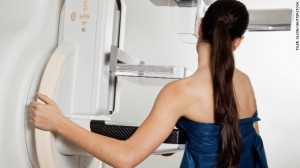Breast cancer screening Qs answered
2013-10-07
By Dr. Otis Brawley, CNN contributor
For years there has been much discussion about mammography screening. Several medical organizations have reviewed the scientific literature and made various recommendations — to begin screening at age 40, or to begin at age 50. Some recommended screening every year; others said every two years.
Since the 1960s, doctors and patients have believed that mammographic screening and early detection of breast cancer, combined with effective treatment, will save lives. There are now at least eight large clinical trials that definitively show screening saves lives for women aged 50 to 69.
Unfortunately, the data for women aged 40 to 49 are not as clear.
Because of that, confusion surrounds breast cancer screening. In honor of Breast Cancer Awareness Month, I decided to tackle some of the most common questions:
Why is mammography a better test for older women?
The answer is twofold: It is easier to see a cancer in mammograms of older women, and older women are more likely to have cancer.
When the radiologist reads a mammogram or X-ray of the breast, cancer appears white. Young breasts have more dense tissue compared to older breasts; a dense breast appears white on mammogram. So in younger women, the radiologist is looking for white on a white background.
The aging of the breast slowly turns its X-ray appearance from white to black. In the breast of a 60- or 70-year-old woman, the radiologist is looking for white on a black background. For women in their 40s, the background can range from whitish to grayish, depending on the density of the individual’s breasts.
A mass seen on a mammogram done on an older woman is also more likely to be cancer than one found in a younger woman. One in every 42 women will develop breast cancer in their 60s, compared to one in 28 women in their 50s. So a mass found in a younger woman may not have an effect on saving her life. In fact, it could do the opposite if unnecessary treatment is performed.
What are some of the limitations of mammography?
Mammography screening is not very effective in women between the ages of 20 and 40, and only moderately effective in women aged 40 to 49.
It is estimated through mathematical modeling that regular screening of a woman between ages 40 and 49 will decrease her risk of breast cancer death by about 15%. In comparison, clinical trials show that screening reduces risk of death by 20% to 35% in women aged 50 to 70.
It is estimated that 1,900 women will have to undergo an annual mammogram in order to save one life. A substantial number of these women (by some estimates more than half) will have an abnormal screen during that decade. These abnormal screens require additional testing and inconvenience. This, of course, also causes a lot of fear and worry. Most of those abnormalities will turn out to be clinically insignificant.
One harmful effect of screening women aged 40 to 49 is that some women have such a bad experience with callbacks for re-evaluation that they stop getting screened, and even refuse screening when they are in their 50s and 60s, when mammography is a more useful test.
Some organizations recommend screening every other year versus every year. There are data to suggest that every-two-year screening saves almost as many lives (about 85% to 90%) as every-year screening, but the number of false positives is halved.
What do the most respected organizations recommend?
While most American organizations recommend annual, high-quality screening beginning at age 40, a few recommend routine mammography start at age 50. Even these organizations say that women who are very concerned about breast cancer and want to start earlier can do so. The choice is yours.
But as you make that choice, know the limitations of mammographic screening.
It is a fact that high-quality breast screening will find some abnormalities that, after extensive evaluation, turn out not to be cancer. High-quality evaluation will miss some cancers. This is especially true in younger women, and can be true even in older women with denser breasts.
So should younger women get screened?
A small number of women will develop breast cancer before the age of 40. No organization recommends mammography for average-risk women under 40.
Women without a family history and with average risk should receive a clinical breast examination with their regular gynecologic examination. They should also be aware of their bodies and get medical assistance if they detect a change in their breast.
Those who have a family history of early breast cancers should consult a physician with expertise in breast cancer. Some of these women will be candidates for screening using magnetic resonance imaging.
The opinions expressed in this article are solely those of Dr. Otis Brawley.


